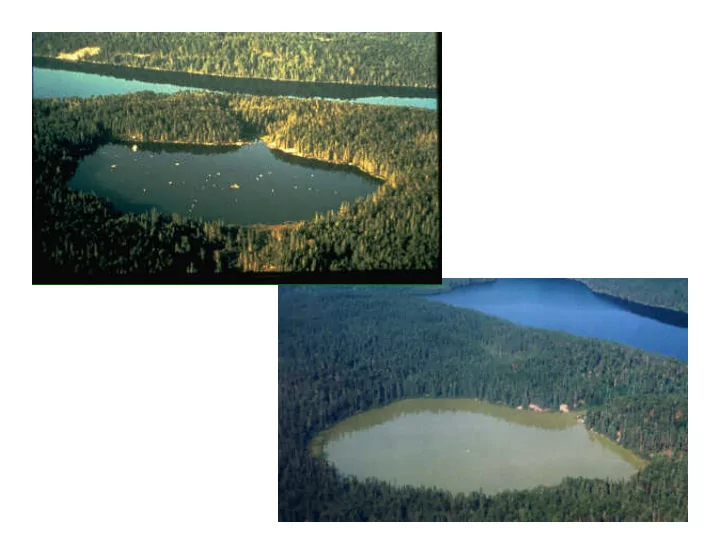

What Does Algae Have To Do With It? • The photosynthetic cyanobacteria, A.K.A. blue-green algae, constitute a major component of the photoplankton and are discussed throughout this treatment as functionally similar to planktonic algae • Algae and cyanobacteria are found in all bodies of water in non-detrimental amounts.
Basic Algal Information • Simple prokaryote cell • Occur in unicellular, filamentous, and colonial forms • Green algae are almost totally freshwater in distribution • Generally reproduce asexually, vegetatively – Occurs mostly at night • Production controlled through water temperature, light, nutrients (particularly P), residence time, and predator activity
What Does This Mean For You? • Algae is becoming a nuisance – Water discoloration and scum formation – Filamentous mats can form at the bottom and float to the surface • You don’t know there is a high quantity until its at the surface – Poor taste and odor of the water – Toxins – kill animals and cause illness in humans – Combination of algal organic matter and chlorine disinfectant can form potential carcinogenic byproducts
Your Health • Health effects associated with exposure to high concentrations of cyanobacterial toxins include: – stomach and intestinal illness; – trouble breathing; – allergic responses; – skin irritation; – liver damage; and – neurotoxic reactions, such as tingling fingers and toes • Scientists are exploring the human health effects associated with long-term exposure to low levels of cyanobacterial toxins. Some studies have suggested that such exposure could be associated with chronic illnesses, such as liver cancer and digestive-system cancer.
Cyanobacteria Data from September 2007 Depth 0.5 1.5 2.5 3.5 4.5 5.5 6.5 Species Total counts Anabaena 3 3 4 14 7 2 33 Aphanocapsa 50 15 4 69 Coelosphaerium 51 51 7 3 112 Microcystis 100 33 34 100 71 2 340 Tabelllaria 1 1 Asterionella 1 1 Oscillatoria 1 100 72 24 197 Mallomonas 1 1 2 Melosira 2 2 Dinobryon 2 1 3 Synura 1 1 Ceratium 100 34 100 1 1 236 Pediastrum 1 1 2 Staurastrum 50 10 20 46 7 1 134 Total counts 359 97 210 260 100 99 8 1153
Willand Pond’s Sources of Phosphorus
DO (mg L -1 )
How Willand Pond’s Morphometry affects Phosphorus Precipitatio n Runoff
Phosphorus Data ( μ g L -1 ) September 2007 April 2008 • Sample was taken at • Staples drain: deepest spot in the lake 193. 3m below the surface 2 • Shore (behind Staples drain) 84.3 23.4 • Boat Launch Shore: 64.3 • Behind Retention Pond: 569.2
Solutions for Willand Pond: •Need a formal monitoring program involving residents, lakes association and coordination with state biologists. •Gather more data on lake natural nutrient cycling • VLAP with NH DES •NH LLMP with the University of New Hampshire •Physical changes or treatments possibly needed for Willand Pond: •Alum treatment •Selective draining •Construction of an outlet •Decreasing external phosphorus sources •Hypolimnetic aeration or oxygenation
NH VLAP: • Volunteer Lakes Assessment Program (VLAP) through NH DES. • Program serves a dual purpose by establishing a regular volunteer-driven lake sampling program to assist DES in evaluating lake quality throughout the state, and by empowering volunteer monitors and lake residents with information about the health of their waterbody. • Usually done several times on a monthly basis throughout the summer months (June-August). • Environments monitored: Groundwater, Lake or Pond, Land, Reservoir, River or Stream, Wetland • Data is interpreted and compiled into a report for each lake.
NH VLAP Sampling and Testing: • Environments monitored: • Lake or Pond, Land, and Reservoirs. • Physical/chemical monitoring: • Conductivity, Alkalinity, pH, Phosphorus, Secchi transparency, and Turbidity. • Biological monitoring: • Bacteria, and Chlorophyll.
NH LLMP: • New Hampshire Lakes Lay Monitoring Program (LLMP) through the University of New Hampshire. • Program dedicated to preservation and sound management of lakes through citizen-based monitoring and research. • Founded in 1978, LLMP is administered jointly through the Cooperative Extension and the Center for Freshwater Biology at the University of New Hampshire. • Provides better view of overall system health by using more extensive testing and sampling. • Through its integration of research, outreach and teaching, the LLMP provides valuable data on the lakes of New Hampshire, broad community service and a unique opportunity for hands-on learning and employment of students.
Recommend
More recommend